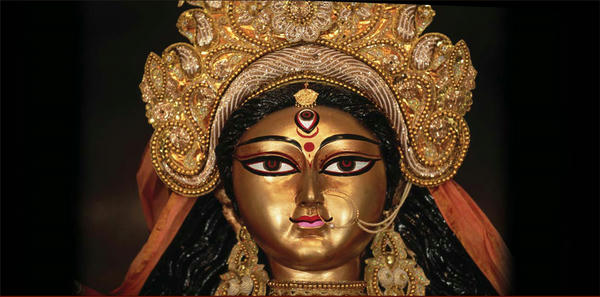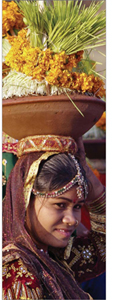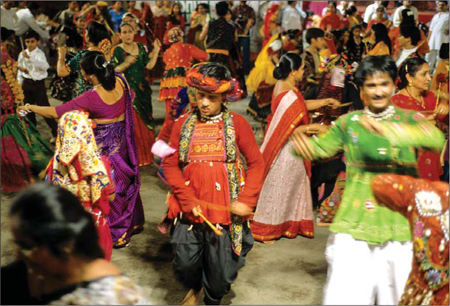
Navaratri
Dedicating 9 Nights to the Goddess
Millions of Hindu women consider Navaratri the year’s central festival, the one they most deeply connect to. These nine days dedicated to Shakti, the Goddess, provide an opportunity to seek blessings and commune with their own divinity. It is a time for sacred gatherings, austerities, selfless acts and intimate prayers. But Navaratri is not just for the ladies; everyone turns out for the joyous worship, festivities, plays, feasting and dance—all venerating God as the loving Mother Spirit that gives life to everything. §
What do Hindus do for Navaratri?§
Navaratri starts on the new moon of September/October. On the first day, it is customary to plant seeds in a clay pot which will sprout over the next nine days. In some communities, women prepare a specially decorated kalasha, a vessel symbolizing the fertile womb, representing the Goddess. Especially in cities in Tamil Nadu, families create elaborate shelf displays, called kolu, of handmade clay dolls. Adding new dolls each year and handing the collection down to the next generation results in some grand displays. §
How is Navaratri observed in homes?§
Each night, the Goddess “holds court,” and special food offerings are presented as prayers eulogizing Her powers are chanted. Guests are invited to showcase their artistic skills, and all enjoy sweets and other treats. Women dress up and visit female friends and relatives, taking a tray of offerings which includes the betel leaf and nut that bear the gravity of a formal contract of friendship and loyalty. Other items on the tray—beauty accessories, fresh turmeric root and coconut—symbolize goodwill and fertility. They fast, pray morning and evening, and give food and cooking pots to the poor. Some families formally honor a prepubescent girl each day, giving her new clothes, treating her to a sumptuous lunch, and pampering her, affirming her femininity and affinity with the Goddess. §
How are Shakti’s forms worshiped? §
In South India the first three days are dedicated to Goddess Durga, the fierce Mother who decimates negative forces. For the next three days, Lakshmi, the Goddess of prosperity, is revered. The last three days are dedicated to Sarasvati, the Goddess of learning and wisdom. In this way, Hindus honor women as the protectors of the family, extol their powers of fertility and endurance, venerate them as the source of good fortune and revere them as repositories of culture and learning. In North India one of the nine aspects of Durga is venerated each day. These nine days are celebrated by communities in East India as Durga Puja, treating the Goddess as the Daughter who has come to her maternal home for an annual visit. §
What is the final day? §
Vijaya Dashami, “triumphant tenth day,” celebrates Durga’s legendary victory over Mahishasura, a powerful being fraught with ignorance and selfishness. On the same day many celebrate Rama’s victory over the evil Ravana. The celebration is a reminder to persist in the challenges we face in life. Local traditions vary widely, and this day is known by other names, including Dussehra, Dasara and Dashain. §
Tidbits About Navaratri

![]() Books, musical instruments, equipment and tools are placed before Goddess Sarasvati for blessings, seeking Her gifts of talent, ability and inspiration. This rite, called Ayudha (weapon or tool) Puja, began when the kings of ancient India had their weapons blessed. Today any tool of one’s trade may be consecrated: craftsmen’s tools, books, offices, vehicles, computers, even iPhones! Devotees reflect on their skills, strengths, goals and needs. A key rite of passage for children ages three to five is performed on this day. Called vidyarambha, “beginning of learning,” it marks the start of a child’s formal education.§
Books, musical instruments, equipment and tools are placed before Goddess Sarasvati for blessings, seeking Her gifts of talent, ability and inspiration. This rite, called Ayudha (weapon or tool) Puja, began when the kings of ancient India had their weapons blessed. Today any tool of one’s trade may be consecrated: craftsmen’s tools, books, offices, vehicles, computers, even iPhones! Devotees reflect on their skills, strengths, goals and needs. A key rite of passage for children ages three to five is performed on this day. Called vidyarambha, “beginning of learning,” it marks the start of a child’s formal education.§
![]() In the evenings, devotees gather to dance in halls and public squares. The Garba, Gujarat’s popular folk dance, is a vigorous dance performed in circles while twirling, jumping, flailing the arms, clapping rhythmically and stepping in sync. In the Dandiya-Ras, sticks are part of the choreography. Dancing is a community expression of joy and togetherness. §
In the evenings, devotees gather to dance in halls and public squares. The Garba, Gujarat’s popular folk dance, is a vigorous dance performed in circles while twirling, jumping, flailing the arms, clapping rhythmically and stepping in sync. In the Dandiya-Ras, sticks are part of the choreography. Dancing is a community expression of joy and togetherness. §
Hinduism: Fact & Fiction
FACT: Hindus place high value on self improvement through education and learning of all kinds. In bygone days women and men were educated from age seven: students lived as part of their teacher’s family. Hindus revere women as the guardians of culture, family, religion, learning and prosperity. Modern Hindu society has the highest number of female spiritual leaders in the world.§
FICTION: Many wrongly believe that Hindu women are prohibited from learning, performing rites, ritual and prayer. Hindu women are not oppressed or considered unequal to men, but honored and respected. Hinduism is the only major religion to honor God’s feminine power!§
Sundal
This is a high-protein, low-oil dish made from steamed or boiled whole chickpeas. §
Preparation time: Approx. 1 hour
Serves: 6 §
Equipment: A pressure cooker, a ladle, a wok or saucepan and a dish§
Ingredients
1 cup chickpeas, ½ tsp turmeric powder, 3 tbsp to ½ cup grated coconut, 1 tsp black mustard seeds, broken dried red chillies (to taste), ½ tsp asafoetida powder, sliced green chillies (optional), curry leaves, salt§
Method§
- Beforehand, soak the chickpeas for 12 hours. Cook with the turmeric powder and salt in a pressure cooker (1:2 ratio of beans to water) until soft but firm, not mushy. Drain and set aside.
- Heat ghee; add the mustard seeds and let them pop.
- Add the curry leaves, chillies and asafoetida; roast the mixture slightly.
- Add the cooked chickpeas. Stir gently over a low flame, taking care not to mash them.
- Add grated coconut and salt to taste. Mix well.
- Enjoy!

